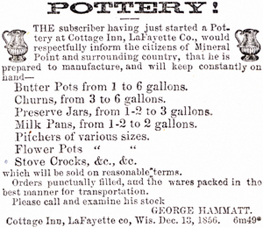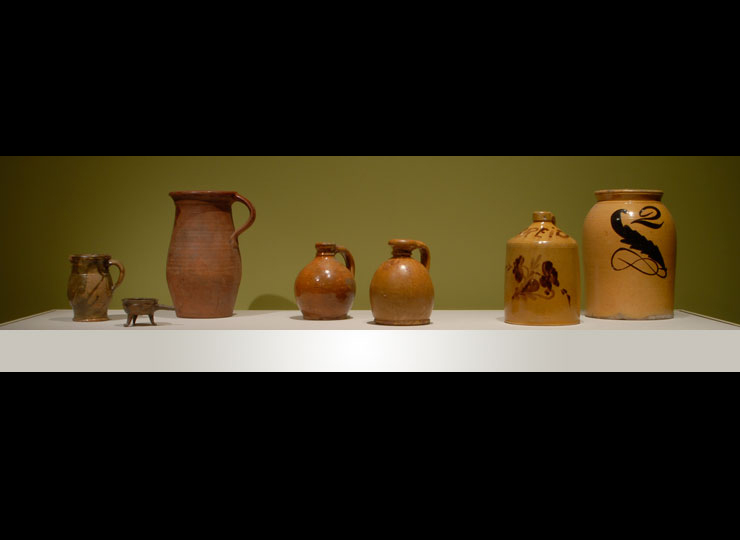Potters in early Wisconsin took advantage of the region’s rich natural resources. Earthenware makers dug locally for their red and yellow clays, mixed glazes from lead mined in the southwest part of the state, and powered kilns with wood from nearby forests. They supplied the settlers in their own and surrounding communities with a wide variety of forms including jars, crocks, pots, and churns for food storage and preparation.
Many of Wisconsin’s early potters learned their craft in their homeland prior to immigrating to America. After arriving here they established new potteries and passed the trade on to other family members and local apprentices. Find more examples of Wisconsin earthenware in the Wisconsin Decorative Arts Database.
August Henschel
(b. Berlin, Germany, 1823–1901)
Mug, ca. 1856–1900
Colgate, Wisconsin
Lead-glazed earthenware
Lent by the Mericle Family Collection
August Henschel
(b. Berlin, Germany, 1823–1901)
Toy Posnet, ca. 1856–1900
Colgate, Wisconsin
Lead-glazed earthenware
Lent by the Mericle Family Collection
Conrad Langenberg
(b. Lippe-Detmold, Germany, 1830–1899)
Milk Jug, ca. 1856–93
Franklin, Wisconsin
Lead-glazed earthenware
Lent by Kenosha Public Museum
George Hammett
(b. Devon, England, ca. 1810–1880)
Jug, ca. 1853–80
Cottage Inn, Wisconsin
Lead-glazed earthenware
Lent by Wisconsin Historical Society
George Hammett
(b. Devon, England, ca. 1810–1880)
Jug, ca. 1853–80
Cottage Inn, Wisconsin
Lead-glazed earthenware
Lent by Kenosha Public Museum
Jar, ca. 1845–67
Whitewater, Wisconsin
Lead-glazed earthenware
Lent by Peter Maas
Jug, ca. 1845–67
Whitewater, Wisconsin
Lead-glazed earthenware
Lent by Franklin Stoneburner
August Henschel of Colgate, Waukesha County came from Berlin, Germany about 1856. Henschel’s mug and tiny toy cooking pot get their green color from a glaze containing copper oxide. The mug’s shape is reminiscent of a form common in seventeenth-century Germany and Britain.
Conrad Langenberg emigrated from Lippe-Detmold, Germany and settled in Franklin, Sheboygan County in 1856. This milk jug, used for separating cream, is a typical example of his work.
George Hammett left Devon, England for America around 1850 and established a pottery in Cottage Inn, Lafayette County with his two sons.
Between 1845 and 1882, the city of Whitewater was home to five potteries operated by both German immigrants and settlers from New York. Early examples of Whitewater pottery are painted with flowers and capacity numbers in dark brown glaze, in imitation of the decorated stoneware that would have been familiar to local customers. Earthenware potters in Wisconsin rarely signed or marked their work. The Whitewater-made jug with the name “A. Reid” is a notable exception.
QUOTE
“Cole and Hunter own and occupy and run the large Whitewater pottery on James Street, directly in front of the south side of the R. R. passenger depot. This business employs from 15 to 20 hands and three heavy teams, uses horse power for grinding the clay, and consumes over 400 cords of wood and 250 loads of clay annually, besides about 15,000 lbs. of mineral for glazing their ware.
The clay is procured entirely in town and within a few miles from here and costs about one dollar and a half per load; and the mineral is brought mostly from Grant County and costs $37 ½ per thousand. The manufactures of this establishment embrace all kinds of
earthenware to the amount of 200,000 gallons, valued at about $14,000, annually.
They have two large kilns for burning ware, one of 2,000 and the other of 3,000 gallons capacity. This business is carried on in a quiet unostentatious manner and the proprietors are true patterns of promptness and honor. A visit and inspection of their works is a rare treat to the uninitiated and curious.”
—Excerpt, L. K. Hawes, “An Exhibit of the Business of the Village of Whitewater,” Whitewater Register, April 26, 1861.
Mineral Point Tribune Ad, December 13, 1856


